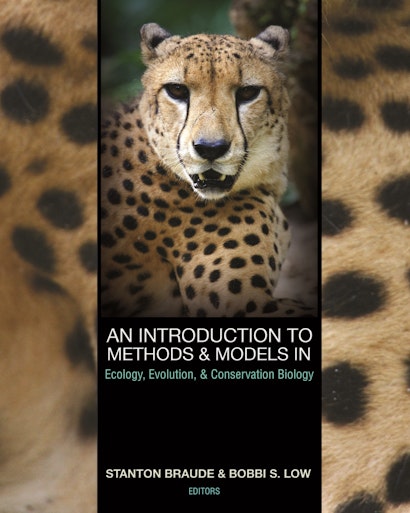This unique textbook introduces undergraduate students to quantitative models and methods in ecology, behavioral ecology, evolutionary biology, and conservation. It explores the core concepts shared by these related fields using tools and practical skills such as experimental design, generating phylogenies, basic statistical inference, and persuasive grant writing. And contributors use examples from their own cutting-edge research, providing diverse views to engage students and broaden their understanding.
This is the only textbook on the subject featuring a collaborative “active learning” approach that emphasizes hands-on learning. Every chapter has exercises that enable students to work directly with the material at their own pace and in small groups. Each problem includes data presented in a rich array of formats, which students use to answer questions that illustrate patterns, principles, and methods. Topics range from Hardy-Weinberg equilibrium and population effective size to optimal foraging and indices of biodiversity. The book also includes a comprehensive glossary.
In addition to the editors, the contributors are James Beck, Cawas Behram Engineer, John Gaskin, Luke Harmon, Jon Hess, Jason Kolbe, Kenneth H. Kozak, Robert J. Robertson, Emily Silverman, Beth Sparks-Jackson, and Anton Weisstein.
- Provides experience with hypothesis testing, experimental design, and scientific reasoning
- Covers core quantitative models and methods in ecology, behavioral ecology, evolutionary biology, and conservation
- Turns “discussion sections” into “thinking labs”
Professors: A supplementary Instructor’s Manual is available for this book. It is restricted to teachers using the text in courses. For information on how to obtain a copy, refer to: http://press.princeton.edu/class_use/solutions.html
"Braude and Low provide a survey of a wide variety of extended exercises in evolutionary biology, population ecology, population genetics, and statistical analysis. Individual chapters can also serve as useful supplement assignments in many introductory biology courses."—Choice
"[This book] is for people like me—faculty members who will buy it and then tinker with, modify, adapt, or steal outright the exercises it contains for use in their own relatively narrowly focused courses. And that is actually a valuable contribution to American biological education!"—Arthur M. Shapiro, Quarterly Review of Biology
"I liked An Introduction to Methods and Models in Ecology, Evolution, and Conservation Biology, and think it would be a very good text in the classroom. This book is intended to function as a lab book, teaching students topics conceptually, encouraging users to work out expectations by hand and by sketching out expected outcomes."—J. Michael Reed, Ecology
"I liked An Introduction to Methods and Models in Ecology, Evolution, and Conservation Biology and think it would be a very good text in the classroom. [The book] presents a nice selection of problems across the broad topics covered."—J. Michael Reed, Ecological Society of America
"[A]n excellent source of tools and inspiration and well suited to prepare the undergraduate student for the methodological and numerical approaches used in ecology and evolution."—Yann Clough, Basic and Applied Ecology
"The most enjoyable aspect of this book is that it is a true teaching guide. The authors expose students to quantitative methods using a very hands-on approach. This approach ensures students feel more comfortable with data analysis and quantitative methods, while also aiding them to develop critical thinking and problem-solving skills. A wealth of personal experience as a student and teacher has obviously gone into the creation of this book, and I would highly recommend it to educators dealing with components of this text"—.Brad J. Farmilo, Austral Ecology
"Braude and Low combine approaches and methodologies from ecology, evolution, and behavior, and emphasize quantitative exercises. Most other books that I'm familiar with are largely focused on either ecology or evolution. It makes sense to me to combine all of this material under a single cover. I can't think of another book like this one."—Jonathan Shurin, University of British Columbia
"A very worthwhile contribution. The authors expose students to quantitative methods using a very hands-on approach. The exercises increase students' comfort with data analysis and quantitative methods while also helping them to develop independent critical thinking and practical problem-solving skills. I do not know of any other textbook that offers this approach in evolution and ecology."—Suzanne H. Alonzo, Yale University
"This book is designed to teach basic ecological methods to undergraduates using a series of interactive exercises. It promotes real learning as opposed to memorization. It is a significant contribution to the field."—Susan L. Keen, University of California, Davis
"This is an interesting and even entertaining book of lab and field exercises that represent a wealth of personal experience in teaching the essentials of ecology and evolutionary theory, as well as the basics of the scientific method, study design, and analysis. The book includes many gems."—David K. Skelly, Yale University

